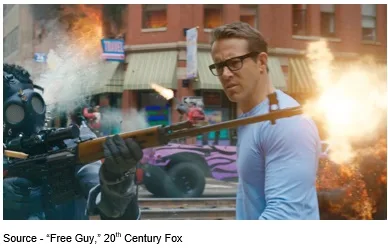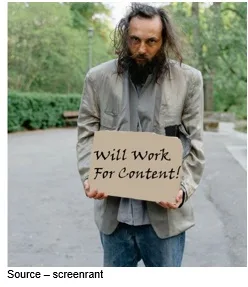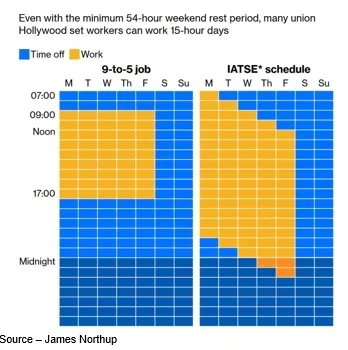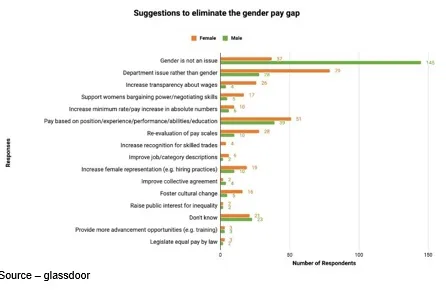Backbone of the M&E Industry Goes Largely Unheralded

How can the film industry people have all of those extravagant award contests, but we never see a category for the most creative folks in the creation/production industry?
Studios and A-Listers all know who they are, but they never get any recognition, any respect.
The industry’s lawyers and accountants can write a contract that gives you the greatest frontend/backend payments, maximum residuals possible.
They can give you the wiggle room you need to prove a big success was all because of you or that the totally rotten tomato was all someone else’s fault for not listening to you.
Wading through seemingly endless columns of numbers, they can show you the project lost so much money they’ll be lucky to pay the electric bill next year.
Or, they can turn the ledgers into ingots of gold to prove in black and white that they easily owe you a gazillion bitcoins.
The industry’s lawyers and accountants both proved their worth during the content industry’s two-year hiatus when great projects sat gathering dust in global libraries and when nothing could be put into the creative pipeline.
Take Warner’s move to throw everything onto HBO Max because people were desperate to see the content and theaters were spookily dark. The brilliant move, which just happened to benefit the company’s fledgling streaming service, cost the company an estimated $200M plus in A-List/agent pay offs.
Fights Back – Scarlett Johanson

stood by her contract and said she was due backend payments for her work on Black Widow and Disney reluctantly agreed. Studio executives took a new look at their A-List contracts and made changes.
Scarlett Johansson squeezed Disney for an extra $80M – on top of her base $20M – for Black Widow because she had been guaranteed a beautiful theatrical window that would have produced hundreds of millions in profits to the Mouse House.
And to show there were no hard feelings, she signed up for a new secret Marvel project (Disney owns Marvel) even before all of the checks had cleared the bank.
During the extended hiatus, the nearly 200,000 worldwide cinema screens were dark and the streaming services became de rigueur for organizations that wanted to turn their video stories into cash and for people who were tired of the rising cost of their pay TV bundles.
Folks everywhere eagerly embraced the idea of having great content any time they wanted it on any screen.
And every studio, network and content aggregator took maximum advantage of the DTC (direct to customer) opportunity.
The changed environment crushed yesteryear’s theatrical window and the old box office-based compensation model.

While there is now a tremendous backlog of projects to be made and shown, a more important shift has taken place that should have a significant – and positive – impact on the people who are actually creating and producing the content.
The first to provide workplace guidelines was the release of the UK film, TV industries The Looking Glass ‘21 report which had been initiated in 2018 and updated last year.
The report turned the spotlight on a problem that has probably existed since the Golden Age of Hollywood which was legally dismantled in 1948 but formally ended in the 1960s when the talent and pre-production/post-production personnel took their place in a free market.
The British report highlighted issues which probably exist across the industry:
- 78 percent of the respondents reported that work intensity was causing poor mental health compared to 63 percent in 2019
- 57 percent said that in the past year, they had experienced bullying; sexual, racial or other harassment or discrimination
- 39 percent of Black, Asian and minorities had experienced racialized harassment or discrimination with 43 percent considering leaving the industry
- 51 percent said the industry’s culture and values were having a negative impact on mental health
- Only 10 percent of respondents said the industry is a mentally healthy place to work
The report was followed by the UK industry’s living document, The Freelance Charter, which is designed to professionalize the industry, invest in its talent and create an ecosystem of respect.
The near shutdown for two years of the industry forced studios, broadcasters and production companies to reassess and reevaluate professionals at all levels.
As projects emerged and got back on track, the UK industry launched The Whole Picture Programme, which ultimately incorporated both physical and mental health guidelines.
Similar initiatives were implemented in other video production centers around the globe.
In addition to having health guideline officials on the set of every project and new physical safety guidelines (social distancing, prepackaged meals, tiered limitations of set personnel, etc.) new professionals were also added to the teams.

Michaela Cole originally brought a mental health specialist on the set of I May Kill You for herself, but the benefits of an on-set therapist were quickly embraced by producers, actors and executives across the country. The specialists became important members of the project teams across Europe, the Americas and now around the globe.
We couldn’t possibly feel the hurt that Cole went through, but we could feel hurt, embarrassed and disgusted about how people treated other people in films like The Underground Railroad, Hidden Figures, and any number of other true or fictionalized films.
We often wondered how people handled working on an especially dark project for hours, days and weeks on end because even if you logically know it’s not real and that it’s only make-believe, there comes a point where your mind makes it feel real.
At the same time, it’s great to say you leave your home problems at home, you really know that is impossible and your mind simply doesn’t let you partition your life that neatly, that easily, that completely.
But perhaps the biggest hurdle that the film industry is slowly beginning to address is that of staff compensation and working conditions.

From the outside, the film industry is delectably glamorous.
From the inside, it’s a job of long hours, performance pressure, minimum rest periods, pay isn’t something you brag about to your neighbors and for many they don’t even get the satisfaction of seeing their names on the closing credits.
It’s not that the industry has been oblivious to the fact that the hours are unlivable, unsustainable and unhealthy; it’s just that as one production person explained, with the demand for new content increasing across the board, “Now they’re just cruel.”

Because of the heavy demand for new content, production and post folks have often observed that in addition to skipped meal breaks and shorter rest periods, Fraturday has become a new day on their calendars – late Friday shoots that run into early Saturday and then back to work on Monday.
Studios, networks, independent content producers and streamers are all doing everything possible to squeeze as much out of every day as possible.
Many pre- through post-production people who were finally able to return to the set were relieved to return to what they enjoyed – creating content for an eager audience – but they also thought that the forced break might make things different and better.
They quickly discovered the pressure had only increased for more 16- to 20-hour days.
A survey by UNI Global Union – the international association of unions and guilds in the media and entertainment sector — found long working hours are now the norm across the film and television industries worldwide.
Workweeks of 50- to 60-hours were increasingly common among production crewmembers in the 20 countries surveyed.
Because of the size and influence of US studios and the rapidly expanding streaming giants (Netflix, Amazon, Disney, WarnerBros Discovery, Peacock, Paramount and Apple), international guilds are hoping the Americas will lead the way to higher standards for the treatment of film and television content production crews.

It will be nice if organizations that announced executive salaries of $30, $40, $50 and even $190M (yes, that includes stock options) would spend a little time to determine how they can implement higher base salaries for the creative people who are making the video stories they’re selling.
Just for the heck of it, they might even make the salaries equitable for everyone involved, including divergent males/females.
After as much as two years of being forced to stay away from the work they seemingly enjoyed, many have also discovered that quality of life should be at the top of their priority list.
It’s going to be difficult if movie houses, broadcasters and streaming services have production/post folks realize they should agree with Guy when he said, “Okay. I WANT to comply. I just find the order of those threats very confusing.”
# # #
Andy Marken – [email protected] – is an author of more than 700 articles on management, marketing, communications, industry trends in media & entertainment, consumer electronics, software and applications. Internationally recognized marketing/communications consultant with a broad range of technical and industry expertise especially in storage, storage management and film/video production fields. Extended range of relationships with business, industry trade press, online media and industry analysts/consultants.